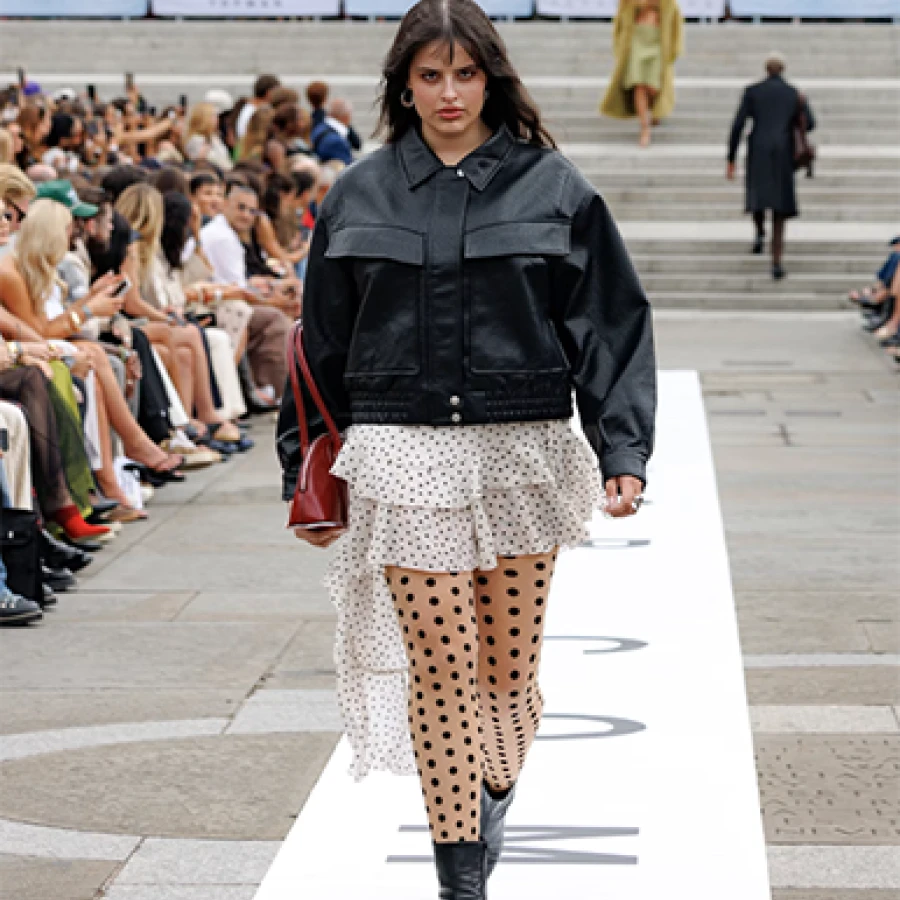Not sure if anyone noticed or cared, but Topshop staged a runway show last week. Yes, Topshop, once the crown jewel of British high street fashion and the Oxford Circus temple where teenagers dragged their parents on Saturday afternoons, made its post-pandemic debut with a splashy open-air spectacle in Trafalgar Square.
This was billed as an “iconic” comeback. The British Fashion Council, now under new leadership after Caroline Rush stepped down earlier this year, treated it as a symbolic moment. London fashion was supposedly reclaiming its rightful place on the global stage. The Mayor of London even turned up to bless it all, as though Topshop had revived the industry from the dead.
But here’s the thing: nobody was asking for Topshop to come back. And certainly not like this.
A Brand Frozen in Time
Topshop was once shorthand for accessible cool, the brand that could keep up with the catwalk at a price teenagers could reach with a weekend job. But that was before Shein. Before TikTok micro-trends. Before dropshipping became a business model. Back then, the competition was Zara, H&M, maybe Bershka. Today, the high street is flooded with ultra-fast-fashion retailers producing clothes faster than anyone can scroll through them.
In that context, Topshop’s runway show felt like a relic. Rather than offering something new, it leaned heavily on nostalgia. The target audience seemed to be thirty-somethings who once trawled the racks at Oxford Circus while their eardrums were assaulted by blasting indie rock. The problem is simple: we have moved on. The idea that Topshop could turn the clock back is naïve at best and insulting at worst.
Ownership Matters
Then there is the ownership question. The media painted this as a British fashion revival. But Topshop is now majority-owned by Heartland, the investment company of Danish billionaire Anders Holch Povlsen. ASOS still holds 25 percent, but this is no longer a British brand. To present it as a patriotic victory for London fashion is misleading if not cynical.
And Heartland’s first big move? Positioning Topshop inside Liberty. Yes, Liberty, the heritage department store synonymous with craftsmanship, rarity and artistry. Pairing Liberty with a fast-fashion label whose website still cannot produce a coherent sustainability statement is baffling. It weakens Liberty’s prestige while doing nothing to elevate Topshop.
Sustainability Theatre
Michelle Wilson, a spokesperson for Topshop, has claimed the brand’s higher prices reflect a more sustainable and better-paid supply chain. Customers, she said, are willing to pay for superior quality. Yet the website is silent on sustainability, fair trade, or basic transparency. If this is a new ethical direction, it is absent from anywhere consumers might read about it.
Instead, what we saw on the runway was a parade of plastics. Faux leather, faux fur, polyester. If the point was to convince us Topshop had grown up, it only reinforced that the brand remains addicted to cheap synthetics that clog wardrobes and landfills.
The opening look was a bubbled faux-leather jacket over a polka-dot dress, tights and boots. The entire composition was synthetic. Topshop used to sell real leather jackets. Now we are offered recession-core knockoffs at PrettyLittleThing prices.
The second look was a floor-length Grinch-green faux fur coat at £140. It screamed Love Island circa 2018, not 2025.
The third look was the one redeeming moment. A pair of jeans with a decent fit. Denim has always been Topshop’s strong suit. But one good pair of jeans does not justify a runway show.
Styling and Inclusivity
Beyond the fabrics, the styling was equally uninspired. It felt like a mood board pieced together by someone who last set foot in a Topshop dressing room a decade ago. The references were clear, but the execution lacked freshness. Nostalgia is a powerful tool, but not if the clothes make you nostalgic for the landfill.
Inclusivity is another problem. ASOS once built credibility with tall, petite and maternity ranges. Topshop’s relaunch cuts off at size 18. For a brand trying to prove relevance, ignoring large parts of the customer base is a curious choice.
Final Thoughts
Topshop wanted this show to be its triumphant re-entry into cultural conversation. Instead, it raised uncomfortable questions. Who is this for. What does it stand for. And why should we care.
The nostalgia might tug at a few heartstrings. But fashion has moved on. Transparency, innovation and inclusivity are what matter now. Polyester dresses on a runway in 2025 are not enough.
Until Topshop figures that out, this is not a revival. It is a rerun.




